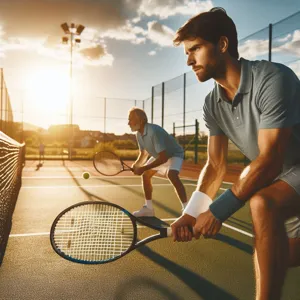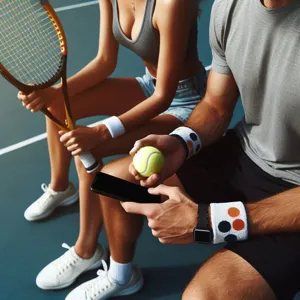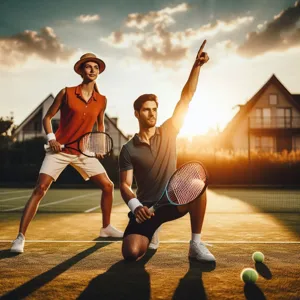Tennis is often celebrated as a sport of finesse, strategy, and competition, but there’s something uniquely enjoyable about sharing the court with a partner in doubles play.
Whether you’re a seasoned player looking to sharpen your skills or a novice eager to learn the ropes, playing doubles not only enhances your game but also fosters camaraderie and teamwork. In this blog post, we’ll delve into the art of doubles tennis, offering essential tips that can elevate your performance and strengthen your partnership. From mastering court positioning and communication to developing effective strategies against your opponents, this guide will equip you with the tools needed to make your doubles experience both thrilling and rewarding. Get ready to serve up some fun as we explore how to turn every match into a delightful experience on the court!
1. Understanding the Basics of Doubles Tennis

Understanding the basics of doubles tennis is essential for anyone looking to improve their game and build a strong partnership on the court. Unlike singles, where the focus is solely on individual performance, doubles requires seamless coordination and communication between partners. The court is wider, which means players must be strategic about positioning and coverage.
In doubles, each player has a specific role, often referred to as the ‘server’ and the ‘receiver,’ but within this framework, flexibility is key. The server initiates the point and aims for placement that creates opportunities for their partner, while the receiver anticipates returns and positions themselves to counter effectively. It’s crucial to establish a clear understanding of your strengths and weaknesses as a team, and to develop strategies that capitalize on these aspects.
Communication is paramount in doubles play. This doesn’t just mean shouting “mine” or “yours” when the ball is in the air; it involves discussing tactics before and during the match, signaling intentions, and providing encouragement. Simple gestures or code words can go a long way in ensuring both players are on the same page, reducing the chance of confusion during fast-paced exchanges.
Additionally, mastering the art of court positioning is vital. The traditional formation features one player at the net and one at the baseline, but effective doubles play often sees players switching positions based on the flow of the game. The net player should remain agile, ready to intercept volleys, while the baseline player focuses on setting up the next shot. Learning to read your partner’s movements and anticipating their needs will foster a more dynamic and cohesive team strategy.
By grasping these key elements—role definitions, effective communication, and strategic positioning—you’ll be well on your way to enjoying the exhilarating experience that doubles tennis offers. Embrace the partnership, and you’ll not only elevate your game but also strengthen your bond with your playing partner.
2. The Importance of Communication on the Court
In the fast-paced world of doubles tennis, effective communication is the backbone of a successful partnership. Unlike singles, where the focus is solely on individual performance, doubles requires a synchronized effort between partners. This means that clear and open communication can make all the difference in your game.
Establishing a rapport begins before the match even starts. Take the time to discuss your playing styles, strengths, and weaknesses with your partner. Are you more comfortable at the net, or do you prefer playing from the baseline? Understanding each other’s preferences will help you develop a strategy that plays to both of your strengths.
Once you’re on the court, verbal cues become essential. Simple phrases like “Mine!” or “Yours!” can prevent confusion and ensure that both players know who is taking charge of a particular shot. Additionally, using hand signals can enhance non-verbal communication, especially during serves or when making strategic plays. This is particularly useful when you want to keep your opponents guessing.
Moreover, keeping an open line of dialogue throughout the match is crucial. Regularly checking in with each other about what’s working and what isn’t will help you adjust your strategy on the fly. A quick thumbs-up or a nod can go a long way in boosting your partner’s confidence and reinforcing teamwork.
Don’t underestimate the power of positive reinforcement, either. Celebrating small victories together, like a well-executed volley or a successful serve, fosters a supportive atmosphere that can elevate your performance. Conversely, if things aren’t going well, approach any criticism constructively. Remember, the goal is to enhance your teamwork, not to assign blame.
In the world of doubles, where synergy reigns supreme, communication is not just an option—it’s a necessity. By honing this critical skill, you and your partner can create an unbreakable bond on the court, turning potential pitfalls into opportunities for victory. So, next time you step onto the court, remember that the key to success lies as much in your words as it does in your swings.
3. Choosing the Right Partner: Skills and Compatibility

When it comes to doubles tennis, the old adage “two heads are better than one” rings especially true, but only if those heads are well-matched. Choosing the right partner can significantly impact your performance on the court, and it goes beyond just finding someone who shares your love for the game. You want a partner whose skills complement yours, creating a dynamic duo that capitalizes on each other’s strengths while covering weaknesses.
First, evaluate your playing style. Are you an aggressive net player who thrives on volleys, or do you prefer a baseline game, patiently rallying until the right moment strikes? Ideally, your partner should have a contrasting style that brings balance to your team. If you’re the aggressive type, pairing up with a steady baseline player can create a formidable force, allowing for strategic play that keeps opponents guessing.
Next, consider your skill levels. While it’s important to challenge each other, playing with someone who is significantly more advanced or less experienced can lead to frustration on both sides. Aim for a partner whose skill level is similar to yours. This can foster a better learning environment, where both of you can grow and improve together. Remember, communication is just as vital as compatibility; you need someone who is willing to discuss strategies, share feedback, and give encouragement.
Then there’s the aspect of compatibility off the court. Tennis is as much about teamwork as it is about individual skill. Find a partner with a similar mindset—someone who matches your competitive spirit, but also knows how to have fun. A positive attitude can make those long practice sessions enjoyable, and a shared sense of humor can ease the tension during tough matches.
Finally, consider logistical factors such as availability, commitment, and location. You want a partner who can consistently practice and compete with you, helping to build that all-important chemistry on the court. By taking the time to thoughtfully choose your doubles partner, you can set the stage for enjoyable games, improved skills, and a rewarding tennis experience that keeps you coming back for more.
4. Court Positioning: Where to Stand for Success
Court positioning is crucial in doubles tennis; it can make the difference between winning a point and losing one. Unlike singles, where you have the entire court to yourself, doubles requires a strategic approach to positioning, as teamwork and communication are key. Let’s break down the essential positions you should consider to maximize your effectiveness on the court.
First and foremost, the classic formation involves one player at the net and the other at the baseline. The net player is your frontline defense and offense, poised to intercept volleys and cut off angles. This player should stand slightly behind the service line to ensure they can react quickly to any shots coming their way, while also being close enough to the net to put pressure on opponents with aggressive volleys. Meanwhile, the baseline player should position themselves a few steps behind the baseline, ready to return serves and rally from the back while keeping an eye on their partner’s movements.
Communication is vital here; make sure to call out your intentions—whether you’re going for the net or holding back—so both players can adjust their positions accordingly. To maintain a solid formation, it’s important for both players to cover their respective sides of the court but also be aware of the center. This is where many teams falter, allowing opponents to exploit gaps.
As the game progresses, be mindful of your opponents’ positioning as well. If they are both at the net, for instance, consider shifting to a side-by-side formation to counter their aggression. Or, if one opponent is consistently hitting to your partner, your role may involve positioning yourself to intercept those shots or create angles that force the opponents out of their comfort zone.
Ultimately, mastering court positioning in doubles is about finding a balance between offense and defense, ensuring you and your partner work in harmony. By staying aware of each other’s positions and intentions, you’ll not only enhance your chances of winning points but also enjoy a more fluid and enjoyable game. So, next time you step onto the court, remember: where you stand can lead to your success!
5. The Art of Serving in Doubles: Strategies and Techniques

When it comes to doubles tennis, mastering the art of serving can be the key to gaining an edge over your opponents. Unlike singles, where the focus is primarily on individual skill, doubles requires a strategic approach that takes into account not only your own capabilities but also the dynamics of your partner and the positioning of your opponents. Here are some essential strategies and techniques to elevate your serving game in doubles.
First and foremost, consider the placement of your serve. In doubles, serving down the middle can create confusion and disrupt the rhythm of your opponents, especially if they are unsure who will take the return. This tactic can open up the court for your partner to capitalize on the weak return. Additionally, varying the speed and spin on your serve can keep your opponents guessing. A well-executed slice serve can pull your opponents wide, allowing you and your partner to take control of the net.
Another critical aspect of serving in doubles is communication with your partner. Establishing a clear strategy before the match, including who covers which areas of the court during the serve, can significantly enhance your team’s effectiveness. For instance, after a serve, one player should be ready to move toward the net while the other prepares for a potential return shot, creating a wall of defense against any counterattacks.
Moreover, practice makes perfect. Spend time honing your serve with your partner, experimenting with different techniques, and working on your timing. Consistency is key; a reliable serve can be a powerful weapon. Incorporate drills that focus on targeting specific areas of the service box, and don’t forget to practice your serve under pressure to simulate match conditions.
Lastly, always stay aware of your opponents’ strengths and weaknesses. If you notice that one player struggles with high balls, consider serving with more topspin to exploit that vulnerability. Adapting your serve based on real-time observations can shift the momentum in your favor.
In summary, the art of serving in doubles is a blend of strategy, communication, and adaptability. By mastering these aspects, you and your partner can turn your serves into powerful tools that not only set the tone for each point but also keep your opponents on their toes. With practice and strategic planning, you’ll find that serving becomes one of your most enjoyable and effective skills on the court.
6. Effective Volleying: Tips for Quick Reactions
Effective volleying is a game-changer in doubles tennis, where quick reactions and sharp instincts can turn the tide of a match in an instant. To excel at the net, you must develop not only your physical agility but also a keen sense of positioning and teamwork with your partner. Here are some essential tips to enhance your volleying skills and ensure you’re always ready to respond to those fast-paced exchanges.
First and foremost, focus on your footwork. A solid foundation begins with being light on your feet. Practice quick lateral movements and short sprints to improve your ability to reach the ball swiftly. Anticipate your opponent’s shots by reading their body language; this will give you a split-second advantage in getting to the ball.
Next, work on your grip and racket positioning. Maintain a continental grip, which is versatile for both volleys and serves. This grip allows for better control and spin on your shots, enabling you to react more effectively to varying ball speeds and angles. Keep your racket head up and ready, as this will help you respond quickly and confidently when the ball comes your way.
Communication with your partner is also crucial during volleying exchanges. Establish clear signals for when to take the lead at the net or when to back off. This not only prevents confusion but also fosters a sense of trust, allowing both players to move fluidly around the court. Practice drills that require quick exchanges at the net, encouraging both of you to call out shots and develop a rhythm.
Lastly, don’t forget the mental aspect of effective volleying. Stay focused and calm under pressure. Visualize successful volleys before they happen, and maintain a positive mindset, even if you miss a shot. Remember, the goal of doubles is not just to win points but to enjoy the game and support each other as teammates.
By honing your volleying skills and enhancing your quick reactions, you’ll become a formidable force at the net, helping your team dominate the court and enjoy every moment of the match together.
7. Developing a Winning Strategy: Offense vs. Defense

In the dynamic world of doubles tennis, the ability to switch between offensive and defensive play can be the key to success on the court. Developing a winning strategy requires a keen understanding of when to attack and when to hold your ground, and this balance can significantly influence the outcome of a match.
**Offensive Play:** Embracing an aggressive style can put your opponents on the back foot. When the opportunity arises, take the initiative by hitting powerful groundstrokes or volleys that challenge your opponents and push them away from their comfort zone. Focus on positioning yourself and your partner to dominate the net, where quick reflexes and decisive actions can lead to winning points. Communicate with your partner to set up plays—consider using signals or pre-arranged tactics that allow you to execute coordinated attacks. Remember, the goal is to create pressure and force errors from your opponents, so be ready to capitalize on any openings that arise.
**Defensive Play:** Conversely, there will be times when adopting a defensive strategy is crucial. This is particularly true when facing a strong opponent or when your team is on the receiving end of a powerful serve. In these moments, your emphasis should shift to maintaining composure and ensuring consistent shot placement. Focus on retrieving shots and returning them with precision, allowing your partner to move into advantageous positions. Communicate clearly about your intentions and be prepared to cover each other’s weaknesses. A solid defensive stance can lead to counterattacks when your opponents overextend, transforming a seemingly dire situation into a potential point-winning opportunity.
Ultimately, the most successful doubles teams are those that can fluidly transition between offensive and defensive play. By developing a strategy that leverages your team’s strengths while adapting to the flow of the game, you can outmaneuver your opponents and create a winning dynamic. Regular practice, paired with thoughtful communication and observation of your partner’s playstyle, will enhance your ability to anticipate each other’s moves and respond effectively during matches. Embrace the thrill of the game and develop a winning strategy that keeps your opponents guessing!
8. The Role of Footwork in Doubles Play
Footwork is the unsung hero of successful doubles play, often overshadowed by flashy serves and powerful groundstrokes. However, mastering your footwork is crucial to not only maintaining court positioning but also enhancing your overall performance as a team. In doubles, the court is inevitably smaller per player, meaning that quick, agile movements can make all the difference in securing those critical points.
First and foremost, good footwork allows you to position yourself optimally for each shot. Rather than simply relying on your upper body strength, focus on staying light on your feet. This means keeping your knees slightly bent and being ready to pivot in any direction. Whether you’re chasing down a swift cross-court volley or positioning yourself for a strategic poach at the net, your ability to move swiftly and decisively will dictate your effectiveness in play.
Moreover, communication with your partner plays a vital role in footwork. As you both navigate the court, maintain an open line of dialogue regarding your movements. A simple call of “mine!” or “yours!” can help both of you avoid confusion and ensure that you each have the best chance at making a play on the ball. When you know your partner’s intended movement, you can adjust your footwork accordingly, creating a seamless flow between you.
Incorporating footwork drills into your practice routine is an excellent way to build muscle memory and enhance your agility on the court. Exercises such as lateral shuffles, quick steps, and even agility ladder drills can sharpen your reflexes and improve your overall court coverage. The more comfortable you become with your footwork, the more you can focus on strategy and shot selection during a match.
Ultimately, remember that in doubles, it’s not just about individual skill; it’s about working cohesively with your partner. Strong footwork will not only elevate your game but also foster better teamwork, allowing the two of you to anticipate each other’s movements and respond effectively to the dynamics of the match. As you enhance your footwork, you’ll find yourself more in sync with your partner, making for a more enjoyable and successful doubles experience.
9. Anticipating Your Partner’s Moves
Anticipating your partner’s moves is a crucial skill in doubles tennis that can elevate your game to new heights. Unlike singles, where you’re primarily focused on your own positioning and tactics, doubles requires a keen awareness of your partner’s actions and intentions. This synergy can make all the difference in your performance on the court.
To start mastering this skill, take note of your partner’s playing style. Are they aggressive at the net, or do they prefer to hang back and play from the baseline? Understanding their strengths and weaknesses will help you predict their next move. For instance, if your partner is known for their powerful forehand, position yourself to cover the court effectively when they’re about to strike.
Communication is another essential component of anticipating your partner’s moves. Establish signals or cues to indicate whether you intend to go for a shot or let them take it. A simple nod or a verbal cue can prevent confusion and ensure that both players are on the same page. During the game, keep an eye on your partner’s footwork and body language; subtle shifts can hint at their next action, allowing you to adjust your positioning accordingly.
Finally, practice makes perfect. Spend time drilling with your partner, focusing on different scenarios that require quick decision-making and anticipation. By honing your ability to read their movements, you’ll not only enhance your own gameplay but also foster a stronger, more cohesive partnership on the court. The more attuned you are to each other, the more fluid your rallies will become, leading to a more enjoyable and successful experience in doubles tennis.
10. Practicing Together: Drills for Doubles Teams
Practicing together is the cornerstone of developing a strong doubles partnership, and incorporating specific drills into your training sessions can significantly enhance your teamwork and skill level on the court. Here are some effective drills that can help you and your partner bond while improving your game.
**1. Cross-Court Rally:** Begin with a simple cross-court rally where you and your partner hit the ball back and forth. This drill focuses on consistency and placement. Aim to keep the ball within the designated area, gradually increasing the speed and intensity. Not only does this enhance your baseline strokes, but it also builds communication and rhythm between partners.
**2. Two-on-One Drill:** This drill is perfect for honing your positioning and defensive skills. One player stands at the net while the other two rally from the baseline. The player at the net practices intercepting shots and volleying, while the baseline players focus on keeping the ball away from the net player. Switch roles periodically to give everyone a chance to practice different aspects of the game.
**3. Serve and Volley:** Serving is crucial in doubles, so practice your serves together. One partner serves while the other practices their volleys at the net. This drill is excellent for working on serve placement and the transition from the baseline to the net. After a few rounds, switch roles to ensure both partners get ample practice in serving and volleying.
**4. Poaching Practice:** Poaching—when the net player crosses into their partner’s territory to intercept a shot—can make or break a doubles game. Set up a drill where one player serves, and the other practices poaching at the net. Focus on timing and communication; calling out “mine” or “yours” can help prevent confusion during actual matches.
**5. Game Scenarios:** Mimic match situations by playing out game scenarios. Set specific targets, like winning a point through effective teamwork or executing a particular strategy. This not only reinforces skills but also helps you and your partner develop a game plan and tactics that suit your playing style.
By incorporating these drills into your practice routine, you and your partner will not only improve your individual skills but also strengthen your chemistry on the court. Remember, the key to successful doubles play lies in communication, trust, and a shared commitment to improvement. So grab your rackets, hit the court, and enjoy the journey of becoming a formidable doubles team!
11. Handling Pressure: Staying Composed in Matches
Handling pressure during tennis matches, especially in doubles, can be a game-changer. The dynamic of partnering with another player adds a layer of complexity, as you not only have to focus on your own performance but also support your partner through high-stakes moments. Staying composed is essential for maintaining your team’s momentum and confidence.
First and foremost, it’s crucial to develop a pre-match routine that helps ground you. This could be as simple as taking a few deep breaths, visualizing successful plays, or engaging in light conversation with your partner to foster a positive atmosphere. Remember, confidence is contagious; when you exude calmness, your partner is likely to feel it too.
During the match, keep your focus on the present moment. It’s easy to become overwhelmed by the score or the importance of a particular point. Instead, break the match down into smaller, manageable pieces. Concentrate on your next serve, the upcoming volley, or your positioning on the court. This approach minimizes anxiety and helps you maintain clarity in your actions.
Communication is also vital when handling pressure. Use clear, encouraging language with your partner. Simple phrases like “I’ve got this” or “Let’s reset” can help reinforce your unity and bolster morale. Additionally, have a plan for handling mistakes—whether it’s acknowledging errors with a quick smile or a light-hearted joke. This fosters a supportive environment where both partners feel empowered to play their best.
Lastly, embrace the importance of resilience. In doubles, the ebb and flow of the game can lead to momentum shifts, but staying composed and encouraging each other can turn the tide. Remember, every point is a new opportunity to refocus and recalibrate. By maintaining your composure and supporting one another, you’ll not only navigate pressure more effectively but also enhance the overall experience of playing together.
12. Analyzing Opponents: Reading Their Game
Analyzing your opponents is a crucial skill in doubles tennis, one that can significantly elevate your game strategy and enhance your teamwork. The ability to read your opponents not only allows you to anticipate their shots but also helps in formulating a game plan that plays to your strengths as a team. As you step onto the court, take a moment to observe your rivals. Watch their footwork, shot selection, and preferred angles. Do they tend to favor forehands over backhands? Are they comfortable at the net, or do they seem more at ease in the baseline rallies?
Pay close attention to their communication style, too. Do they frequently call for the ball, or are they more reserved? Understanding their dynamics can give you insights into whether they might struggle under pressure or thrive in it. If one opponent is consistently quick to the net, consider directing your shots towards their partner, thereby creating openings for your own plays.
Don’t forget about your partner—your observations and insights should be communicated clearly during the match. Create a strategy based on what you’ve gathered; perhaps one of you focuses on intercepting volleys while the other covers the back court. Adaptability is key—if you notice your opponents changing their tactics, be ready to adjust yours accordingly.
By honing your ability to analyze your opponents’ games, you’ll not only empower yourself and your partner with strategic advantages but also deepen your understanding of the game itself. Remember, tennis is as much about mental agility as it is about physical prowess, and being able to read your opponents makes you a formidable force on the court.
13. Sportsmanship: Building a Positive Playing Environment
Sportsmanship is the cornerstone of any successful doubles partnership and plays a crucial role in fostering a positive and enjoyable playing environment. When you step onto the court, it’s important to remember that tennis is not just about winning; it’s also about the camaraderie and respect you share with your partner and opponents. Here are some key aspects of sportsmanship that can elevate your game and enhance the overall experience.
Firstly, communication is vital. Encourage open dialogue with your partner, whether it’s strategizing during a break or offering constructive feedback after a point. A simple “nice shot” or “good try” can go a long way in boosting morale and reinforcing a supportive atmosphere. Remember, positive reinforcement helps build trust and confidence, which are essential for effective teamwork.
Secondly, respect your opponents. Acknowledge their skills and efforts, regardless of the score. When they hit a great shot, give them a nod or a compliment. This not only promotes a friendly environment but also sets a standard for how you wish to be treated in return.
Moreover, maintain a positive attitude, even in the face of defeat. Every match is a learning opportunity, and your response to challenges can inspire your partner and create a resilient bond. If things aren’t going your way, focus on the aspects you can control—like your effort, attitude, and sportsmanship—rather than fixating on the outcome.
Lastly, keep the court clean and organized. This small gesture shows respect for the game and your fellow players. By picking up after yourself and ensuring the area is tidy, you contribute to a positive atmosphere that everyone can enjoy.
In summary, embodying good sportsmanship is about creating a culture of respect, support, and positivity on the court. By focusing on teamwork, maintaining a gracious attitude, and fostering mutual respect, you and your partner can not only improve your game but also create lasting memories together. After all, tennis is as much about the joy of playing as it is about competition.
14. Celebrating Wins and Learning from Losses Together
In the world of doubles tennis, every point scored and every game won is a shared victory that can strengthen your partnership both on and off the court. Celebrating wins together fosters a sense of camaraderie and reinforces your bond as a team. Whether it’s a well-executed serve that catches your opponents off guard or a perfectly timed volley that clinches a game, take the time to acknowledge these moments. A high-five, a fist pump, or simply exchanging smiles can turn a successful point into a memorable memory, boosting morale and creating a positive atmosphere throughout your match.
Equally important is the ability to learn from losses together. In doubles, it’s easy to attribute mistakes to a single player, but true teamwork involves a shared responsibility for both triumphs and setbacks. After a tough match, take a moment to discuss what went wrong and what could be improved for next time. Perhaps a particular strategy didn’t work, or communication faltered during crucial points. By analyzing these experiences as a team, you’ll not only enhance your skills but also deepen your understanding of each other’s playing styles and preferences.
This dynamic of celebrating successes and reflecting on losses can transform your tennis experience into something much more enriching. You’ll find that the emotional highs of victory are even sweeter when shared and that the lows of defeat become stepping stones for future improvement. Embracing this mindset will not only elevate your game but will also forge a lasting partnership both on the court and in your shared love for the sport.
15. Conclusion: The Joy of Playing Doubles Tennis
In conclusion, the joy of playing doubles tennis is an experience like no other. The camaraderie, strategic cooperation, and shared triumphs create a unique bond between partners that transcends the court. As you step onto the vibrant green of the tennis court, you not only engage in a physical challenge but also embark on a journey of teamwork and mutual support. Each serve, volley, and rally becomes an opportunity to communicate, strategize, and celebrate each other’s strengths.
The thrill of executing a well-timed play or saving a crucial point together brings an unmatched exhilaration. Doubles tennis encourages you to develop a deeper understanding of your partner’s playing style and preferences, fostering a sense of unity that can enhance your overall performance. Moreover, the social aspect of doubles allows you to connect with fellow tennis enthusiasts, making every match an opportunity to forge new friendships and strengthen existing ones.
As you embrace the tips shared throughout this guide—be it mastering positioning, improving communication, or honing your teamwork skills—remember that the ultimate goal is to enjoy the game. Celebrate the victories, learn from the losses, and relish the laughter that often accompanies a lively match. Whether you’re a seasoned player or just starting out, the joy of playing doubles tennis lies in the shared moments on and off the court, making every match an unforgettable experience. So grab your racquet, find a partner, and dive into the thrilling world of doubles tennis—where every game is a chance to create lasting memories together.
As we wrap up our exploration of doubles tennis, we hope you feel inspired and equipped to hit the court with your partner in a whole new way. From honing your communication skills to mastering strategic positioning, the tips we’ve shared are designed to elevate your game and deepen your connection with your partner. Remember, the essence of doubles lies not only in the competition but also in the camaraderie and fun that come with playing together. So, gather your gear, find a partner, and put these strategies into practice. With teamwork, practice, and a shared passion for the game, you’ll be well on your way to achieving doubles delight! Happy playing!






